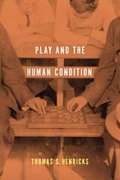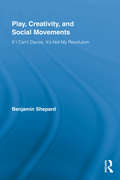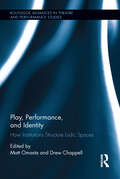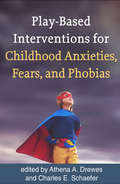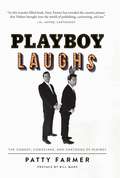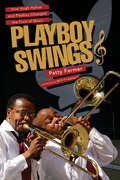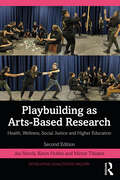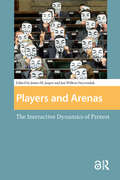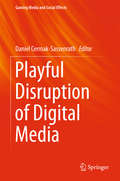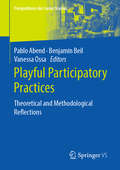- Table View
- List View
Play and playfulness for public health and wellbeing
by Alison Tonkin Julia WhitakerThe role of play in human and animal development is well established, and its educational and therapeutic value is widely supported in the literature. This innovative book extends the play debate by assembling and examining the many pieces of the play puzzle from the perspective of public health. It tackles the dual aspects of art and science which inform both play theory and public health policy, and advocates for a ‘playful’ pursuit of public health, through the integration of evidence from parallel scientific and creative endeavors. Drawing on international research evidence, the book addresses some of the major public health concerns of the 21st century – obesity, inactivity, loneliness and mental health – advocating for creative solutions to social disparities in health and wellbeing. From attachment at the start of life to detachment at life’s ending, in the home and in the workplace, and across virtual and physical environments, play is presented as vital to the creation of a new ‘culture of health’. This book represents a valuable resource for students, academics, practitioners and policy-makers across a range of fields of interest including play, health, the creative arts and digital and environmental design.
Play and the Artist’s Creative Process: The Work of Philip Guston and Eduardo Paolozzi (Routledge Advances in Art and Visual Studies)
by Elly ThomasPlay and the Artist’s Creative Process explores a continuity between childhood play and adult creativity. The volume examines how an understanding of play can shed new light on processes that recur in the work of Philip Guston and Eduardo Paolozzi. Both artists’ distinctive engagement with popular culture is seen as connected to the play materials available in the landscapes of their individual childhoods. Animating or toying with material to produce the unforeseen outcome is explored as the central force at work in the artists’ processes. By engaging with a range of play theories, the book shows how the artists’ studio methods can be understood in terms of game strategies.
Play and the Human Condition
by Thomas S. HenricksIn Play and the Human Condition, Thomas Henricks brings together ways of considering play to probe its essential relationship to work, ritual, and communitas. Focusing on five contexts for play--the psyche, the body, the environment, society, and culture--Henricks identifies conditions that instigate play, and comments on its implications for those settings. Offering a general theory of play as behavior promoting self-realization, Henricks articulates a conception of self that includes individual and social identity, particular and transcendent connection, and multiple fields of involvement. Henricks also evaluates play styles from history and contemporary life to analyze the relationship between play and human freedom. Imaginative and stimulating, Play and the Human Condition shows how play allows us to learn about our qualities and those of the world around us--and in so doing make sense of ourselves.
Play in Clinical Practice
by Sandra Russ Larissa NiecGoing beyond traditional play therapy, this innovative book presents a range of evidence-based assessment and intervention approaches that incorporate play as a key element. It is grounded in the latest knowledge about the importance of play in child development. Leading experts describe effective strategies for addressing a wide variety of clinical concerns, including behavioral difficulties, anxiety, parent child relationship issues, trauma, and autism. The empirical support for each approach is summarized and clinical techniques are illustrated. The book also discusses school-based prevention programs that utilize play to support children's learning and social-emotional functioning.
Play in Healthcare for Adults: Using play to promote health and wellbeing across the adult lifespan
by Alison Tonkin Julia WhitakerPLAY. We all do it: wordplay, love play, role-play; we play cards, play sport, play the fool, and play around. And that’s just the grown-ups! It features in every aspect of our lives, whether we call it by that or another name. We all do it, but why do we do it? What does it mean to play and what, if any, difference does it make to our lives? Most crucially, and central to the theme of this book, is the question, ‘Does play have a positive impact on our health and wellbeing, and consequently a role in modern healthcare delivery?’ The contributors to this book provide a comprehensive overview of how play and play-based activities can be used throughout the adult lifespan to promote health and wellbeing within the context of healthcare service delivery for patients, their families and communities, and for the staff involved in their care. Responding to current global health concerns such as obesity, coronary heart disease, dementia and mental health, the book argues that play and playfulness offer a means of protection, promotion and recovery of positive health and wellbeing. The human tendency for play and playfulness as essential to personal growth and development lie at the heart of the discussion. This book will be of interest to all those working in health or social care settings, including nursing, social work and allied health students and professionals and those working within the therapeutic disciplines of art therapy, music therapy, and recreation alliances.
Play like a Feminist. (Playful Thinking)
by Shira ChessAn important new voice provides a riveting look at why video games need feminism and why all of us should make space for more play in our lives."You play like a girl": it's meant to be an insult, accusing a player of subpar, un-fun playing. If you're a girl, and you grow up, do you "play like a woman"--whatever that means? In this provocative and enlightening book, Shira Chess urges us to play like feminists. Furthermore, she urges us to play video games like feminists. Playing like a feminist is empowering and disruptive; it exceeds the boundaries of gender yet still advocates for gender equality. Feminism need video games as much as video games need feminism.
Play, Creativity and Digital Cultures (Routledge Research in Education)
by Muriel Robinson Jackie Marsh Rebekah WillettRecent work on children's digital cultures has identified a range of literacies emerging through children's engagement with new media technologies. This edited collection focuses on children's digital cultures, specifically examining the role of play and creativity in learning with these new technologies. The chapters in this book were contributed by an international range of respected researchers, who seek to extend our understandings of children's interactions with new media, both within and outside of school. They address and provide evidence for continuing debates around the following questions: What notions of creativity are useful in our fields? How does an understanding of play inform analysis of children's engagement with digital cultures? How might school practice take account of out-of-school learning in relation to digital cultures? How can we understand children's engagements with digital technologies in commercialized spaces? Offering current research, theoretical debate and empirical studies, this intriguing text will challenge the thinking of scholars and teachers alike as it explores the evolving nature of play within the media landscape of the twenty-first century.
Play, Creativity, and Social Movements: If I Can't Dance, It’s Not My Revolution (Routledge Advances in Sociology)
by Benjamin ShepardAs we play, we step away from stark reality to conjure up new possibilities for the present and our common future. Today, a new cohort of social activists are using it to create social change and reinvent democratic social relations. In contrast to work or routine, play must be free. To the extent that it is, it infuses a high-octane burst of innovation into any number of organizational practices and contexts, and invites social actors to participate in a low-threshold, highly democratic process of collaboration, based on pleasure and convivial social relations. Despite the contention that such activities are counterproductive, movements continue to put the right to party on the table as a part of a larger process of social change, as humor and pleasure disrupt monotony, while disarming systems of power. Through this book, Shepard explores notions of play as a social movement activity, considering some of the meanings, applications and history of the concept in relation to social movement groups ranging from Dada and Surrealism to Situationism, the Yippies to the Young Lords, ACT UP to the Global Justice, anti-gentrification, community and anti-war movements of recent years.
Play, Performance, and Identity: How Institutions Structure Ludic Spaces (Routledge Advances in Theatre & Performance Studies)
by Matt Omasta Drew ChappellPlay helps define who we are as human beings. However, many of the leisurely/ludic activities people participate in are created and governed by corporate entities with social, political, and business agendas. As such, it is critical that scholars understand and explicate the ideological underpinnings of played-through experiences and how they affect the player/performers who engage in them. This book explores how people play and why their play matters, with a particular interest in how ludic experiences are often constructed and controlled by the interests of institutions, including corporations, non-profit organizations, government agencies, religious organizations, and non-governmental organizations (NGOs). Each chapter explores diverse sites of play. From theme parks to comic conventions to massively-multiplayer online games, they probe what roles the designers of these experiences construct for players, and how such play might affect participants' identities and ideologies. Scholars of performance studies, leisure studies, media studies and sociology will find this book an essential reference when studying facets of play.
Play-Based Interventions for Childhood Anxieties, Fears, and Phobias
by Charles E. Schaefer Athena A. DrewesIllustrating the power of play for helping children overcome a wide variety of worries, fears, and phobias, this book provides a toolkit of play therapy approaches and techniques. Coverage encompasses everyday fears and worries in 3- to 12-year-olds as well as anxiety disorders and posttraumatic problems. Leading practitioners describe their approaches step by step and share vivid illustrative case material. Each chapter also summarizes the research base for the interventions discussed. Key topics include adapting therapy to each child's developmental level, engaging reluctant or less communicative clients, and involving parents in treatment.
Play-by-Play: Radio, Television, and Big-Time College Sport
by Ronald A. SmithNoted sports historian writes on the relationship of the media to college athletics.Chosen as an Outstanding Academic Title for 2003 by Choice MagazineThe phenomenal popularity of college athletics owes as much to media coverage of games as it does to drum-beating alumni and frantic undergraduates. Play-by-play broadcasts of big college games began in the 1920s via radio, a medium that left much to the listener's imagination and stoked interest in college football. After World War II, the rise of television brought with it network-NCAA deals that reeked of money and fostered bitter jealousies between have and have-not institutions. In Play-by-Play: Radio, Television, and Big-Time College Sport noted author and sports insider Ronald A. Smith examines the troubled relationship between higher education and the broadcasting industry, the effects of TV revenue on college athletics (notably football), and the odds of achieving meaningful reform.Beginning with the early days of radio, Smith describes the first bowl game broadcasts, the media image of Notre Dame and coach Knute Rockne, and the threat broadcasting seemed to pose to college football attendance. He explores the beginnings of television, the growth of networks, the NCAA decision to control football telecasts, the place of advertising, the role of TV announcers, and the threat of NCAA "Robin Hoods" and the College Football Association to NCAA television control. Taking readers behind the scenes, he explains the culture of the college athletic department and reveals the many ways in which broadcasting dollars make friends in the right places. Play-by-Play is an eye-opening look at the political infighting invariably produced by the deadly combination of university administrators, athletic czars, and huge revenue.
Playa Fire: Spirit and Soul at Burning Man
by Stewart HarveyForeword by Burning Man founder Larry HarveyA stunning visual and narrative homage—featuring more than 100 black & white and color photographs, many never before seen—that captures the wonder and metaphysical power of Burning Man past present, and future, and the magic that draws us to it, by the ultimate Burning Man insider.Growing up in 1950s Oregon, brothers Stewart and Larry Harvey rebelled against their small-town culture and the conformist norms of Eisenhower’s America. Stewart turned to photography. Larry, drawn by the siren call of the burgeoning counter-cultural movement, fled to San Francisco, where he met a group of alternative artists like himself. During his frequent visits south, Stewart, camera always in hand, photographed the intimate creative worlds of Larry and his friends—images that would chronicle the birth of one of the most important cultural, artistic, and social movements of the twentieth century: Burning Man.Filled with the rare insights of Stewart’s decades-long friendships with his brother and the five other founders, as well as the many people who have shaped it, Playa Fire is a Burning Man story like no other. An artist and writer of striking emotional depth, Stewart marries stunning photos reflecting the beauty and grandeur of the desert landscape and the ephemeral, hallucinatory beauty of Black Rock City with a compelling narrative journey that captures the landmark festival’s spiritual essence.Drawn from his personal archives and taken over thirty years at Burning Man—many at "First Camp"—his panoramic photographs are accompanied by never-before-seen memorabilia, including Larry’s original sketch of the first Man as well as family photos of the young Harvey brothers and their band of merrymakers. An exquisite work of art that embodies the radical imagination at the core of this transformative event, Playa Fire celebrates both the spectacle and the meditative that is Burning Man. It is an enchanting portrait for die-hard "Burners," arts enthusiasts, and the intellectually curious fascinated by this iconoclastic, beloved cultural phenomenon.
Playbook for Progressives
by Eric MannAn organizing manifesto for the twenty-first century, Playbook for Progressives is a must-have for the activist's tool kit. This comprehensive guide articulates pragmatically what is required in the often mystifying and rarely explained on-the-ground practice of organizing. Here, Eric Mann distills lessons he learned from over forty years as an organizer, as well as from other organizers within the civil rights, labor, LGBT, economic justice, and environmental movements.From the Trade Paperback edition.
Playbook for Progressives: 16 Qualities of a Successful Organizer
by Eric MannAn organizing manifesto for the twenty-first century, Playbook for Progressives is a must-have for the activist's tool kit. This comprehensive guide articulates pragmatically what is required in the often mystifying and rarely explained on-the-ground practice of organizing. Here, Eric Mann distills lessons he learned from over forty years as an organizer, as well as from other organizers within the civil rights, labor, LGBT, economic justice, and environmental movements.
Playboy Laughs: The Comedy, Comedians, And Cartoons Of Playboy
by Patty FarmerFollowing her success with Playboy Swings, Patty Farmer looks at Playboy’s relationship with comedians and cartoonists in her new book Playboy Laughs. Playboy Laughs invites readers onto the sets of the organization’s groundbreaking TV shows, Playboy Penthouse and Playboy After Dark. These popular variety series brought top-tier comedians, impressionists, and monologists—as well as the finest musicians—into people’s homes each week. Readers will learn how before he ever dreamed of conquering the magazine publishing world—and along the way establish a worldwide brand—Hugh Hefner harbored aspirations of making his mark in the world as a cartoonist. Playboy Laughs delves into the darker aspects of the time as well, tackling the ways Playboy and its comedy stars helped break down social and racial barriers as well as sexual ones. Known for her devotion to meticulous research and clear, honest storytelling, Farmer has gained the full cooperation of the Playboy organization—and Hugh Hefner himself—making this not only an entertaining read but a trustworthy history of an under-appreciated aspect of American comic culture.
Playboy Swings: How Hugh Hefner and Playboy Changed the Face of Music
by Will Friedwald Patty FarmerPlayboy—the magazine, the empire, the lifestyle—is one of the world’s best-known brands. Since the launch of Playboy magazine in 1953, two elements have been remarkably consistent: the first, obviously, is the celebration of nubile, female flesh. The second, readers may be surprised to learn, is Playboy’s involvement in the music scene. The Playboy experience was never just about sex but about lifestyle. Music—particularly the finest jazz, a personal passion of Hefner’s—has always been an essential component of that lifestyle. Playboy Swings focuses specifically on Playboy’s involvement in the music scene, its impact on popular entertainment (and vice versa), and the fabulous cadre of performers who took to the stages of the mythic Playboy Clubs and Jazz Festivals. Throughout Playboy Swings, Farmer demonstrates how Playboy helped change the world through music by integrating the TV shows, festivals, and the clubs.Complied through interviews with hundreds of people who were on the scene throughout Playboy’s rise, fall, and on-going renaissance, Playboy Swings carries readers on a seductive journey through the history of the empire—all the while focusing on the musical entertainment that made it unique. Hef’s personal passion for music—and his belief in it as a cornerstone of the Playboy ethos—has expressed itself in a wide range of media over Playboy’s 60-year history, and all of it comes alive in these pages. Famer takes the reader from the inception of the Playboy empire through the 1959 jazz festival, to the opening of club after club.With approximately 60 black and white photos, and a complete Playboy music reference guide, readers will think of music, not just Bunnies, when thinking about Playboy.Throughout the book, it is the artists who do most of the talking—and they have a lot to say about the golden era of Playboy entertainment.
Playboys and Mayfair Men: Crime, Class, Masculinity, and Fascism in 1930s London
by Angus McLarenThe shocking true story of a diamond theft gone wrong.In December 1937, four respectable young men in their twenties, all products of elite English public schools, conspired to lure to the luxurious Hyde Park Hotel a representative of Cartier, the renowned jewelry firm. There, the "Mayfair men" brutally bludgeoned diamond salesman Etienne Bellenger and made off with eight rings that today would be worth approximately half a million pounds. Such well-connected young people were not supposed to appear in the prisoner’s dock at the Old Bailey. Not surprisingly, the popular newspapers had a field day responding to the public’s insatiable appetite for news about the upper-crust rowdies and their unsavory pasts.In Playboys and Mayfair Men, Angus McLaren recounts the violent robbery and sensational trial that followed. He uses the case as a hook to draw the reader into a revelatory exploration of key interwar social issues, from masculinity and cultural decadence to broader anxieties about moral decay. In his gripping depiction of Mayfair’s celebrity high life, McLaren describes the crime in detail, as well as the police investigation, the suspects, their trial, and the aftermath of their convictions.
Playbuilding as Arts-Based Research: Health, Wellness, Social Justice and Higher Education (ISSN)
by Joe Norris Kevin Hobbs Mirror TheatreThe new edition of Playbuilding as Arts-Based Research details how playbuilding (creating an original performative work with a group) as a methodology has developed in qualitative research over the last 15 years.The second edition substantially updates the award-winning first edition by making connections to current research theories, providing complete scripts with URL links to videos, and including a new section with interviews with colleagues. Chapter 1 provides an in-depth discussion of the epistemological, ontological, axiological, aesthetic, and pedagogic stances that playbuilding takes, applying them to research in general. The value of a playful, trusting atmosphere; choices of style, casting, set, and location in representing the data; and pedagogical theories that guide participatory theatre are highlighted. Chapter 2 discusses how Mirror Theatre generates data, structures dramatic scenes, and conducts live and virtual participatory workshops. Chapter 3 is a thematized account of interviews with 23 colleagues who employ variations of playbuilding that show how playbuilding can be applied in a wide range of contemporary contexts and disciplines. Chapters 4 through 9 describe six projects that address topics of drinking choices and mental health issues on campus, person-centred care, homelessness, the transition to university, and co-op placements. They include both a theme and a style analyses and workshop ideas. Chapter 10, new to this edition, concludes with quantitative and qualitative data from audiences attesting to the efficacy of this approach.This is a fascinating resource for qualitative researchers, applied theatre practitioners, drama teachers, and those interested in social justice, who will appreciate how the book adeptly blends theory and practice, providing exemplars for their own projects.
Played Out: The Race Man in Twenty-First-Century Satire
by Brandon J. ManningDating back to the blackface minstrel performances of Bert Williams and the trickster figure of Uncle Julius in Charles Chesnutt’s Conjure Tales, black humorists have negotiated American racial ideologies as they reclaimed the ability to represent themselves in the changing landscape of the early 20th century. Marginalized communities routinely use humor, specifically satire, to subvert the political, social, and cultural realities of race and racism in America. Through contemporary examples in popular culture and politics, including the work of Kendrick Lamar, Key and Peele and the presidency of Barack Obama and many others, in Played Out: The Race Man in 21st Century Satire author Brandon J. Manning examines how Black satirists create vulnerability to highlight the inner emotional lives of Black men. In focusing on vulnerability these satirists attend to America’s most basic assumptions about Black men. Contemporary Black satire is a highly visible and celebrated site of black masculine self-expression. Black satirists leverage this visibility to trouble discourses on race and gender in the Post-Civil Rights era. More specifically, contemporary Black satire uses laughter to decenter Black men from the socio-political tradition of the Race Man.
Player vs. Monster: The Making and Breaking of Video Game Monstrosity (Playful Thinking)
by Jaroslav SvelchA study of the gruesome game characters we love to beat—and what they tell us about ourselves.Since the early days of video games, monsters have played pivotal roles as dangers to be avoided, level bosses to be defeated, or targets to be destroyed for extra points. But why is the figure of the monster so important in gaming, and how have video games come to shape our culture&’s conceptions of monstrosity? To answer these questions, Player vs. Monster explores the past half-century of monsters in games, from the dragons of early tabletop role-playing games and the pixelated aliens of Space Invaders to the malformed mutants of The Last of Us and the bizarre beasts of Bloodborne, and reveals the common threads among them.Covering examples from aliens to zombies, Jaroslav Švelch explores the art of monster design and traces its influences from mythology, visual arts, popular culture, and tabletop role-playing games. At the same time, he shows that video games follow the Cold War–era notion of clearly defined, calculable enemies, portraying monsters as figures that are irredeemably evil yet invariably vulnerable to defeat. He explains the appeal of such simplistic video game monsters, but also explores how the medium could evolve to present more nuanced depictions of monstrosity.
Players and Arenas: The Interactive Dynamics of Protest (Protest and Social Movements)
by James M. Jasper Jan Willem DuyvendakPlayers and Arenas brings together a diverse group of experts to examine the interactions between political protestors and the many strategic players they encounter, such as cultural institutions, religious organizations, and the mass mediaas well as potential allies, competitors, recruits, and funders. Discussing protestors and players as they interact within the arenas of specific social contexts, the essays show that the main constraints on what protestors can accomplish come not from social and political structures, but from other players with different goals and interests. Through a careful treatment of these situations, this volume offers a new way to approach the role of social protest in national and international politics.
Players and Their Pets: Gaming Communities from Beta to Sunset
by Mia Consalvo Jason BegyIn the world of massively multiplayer online games (MMOGs), Faunasphere was but a blip on the screen in its short public life from 2009 to 2011. Its devoted players, many of them middle-aged women, entered a world that did not build on common fantasy or science-fiction tropes. There was no evil to defeat or realms to conquer, only friendly animals to care for and pollution to fight.In Players and Their Pets, Mia Consalvo and Jason Begy argue that its very difference makes it critically important—even more so than the large, commercially successful games such as World of Warcraft that have all too often shaped game studies discourse. Consalvo and Begy demonstrate how the beta period of an MMOG can establish social norms that guide how the game is played. They also show how a game&’s platform creates expectations for how the game will work and who is playing it—and what happens when those expectations clash with the reality. Even while telling the story of this particular game and its predominantly female players, however, Players and Their Pets cautions against oversimplifying players based on their gender. Faunasphere&’s playerbase enjoyed diverse aspects of the game, for varied reasons. No other game studies book tracks the entire life cycle of an online game to examine how the game evolved in terms of design as well as how its player community responded to changes and events. The brief life of Faunasphere makes this possible.
Playful Disruption of Digital Media (Gaming Media and Social Effects Ser.)
by Daniel Cermak-SassenrathThis book starts with the proposition that digital media invite play and indeed need to be played by their everyday users. Play is probably one of the most visible and powerful ways to appropriate the digital world. The diverse, emerging practices of digital media appear to be essentially playful: Users are involved and active, produce form and content, spread, exchange and consume it, take risks, are conscious of their own goals and the possibilities of achieving them, are skilled and know how to acquire more skills. They share a perspective of can-do, a curiosity of what happens next? Play can be observed in social, economic, political, artistic, educational and criminal contexts and endeavours. It is employed as a (counter) strategy, for tacit or open resistance, as a method and productive practice, and something people do for fun.The book aims to define a particular contemporary attitude, a playful approach to media. It identifies some common ground and key principles in this novel terrain. Instead of looking at play and how it branches into different disciplines like business and education, the phenomenon of play in digital media is approached unconstrained by disciplinary boundaries. The contributions in this book provide a glimpse of a playful technological revolution that is a joyful celebration of possibilities that new media afford. This book is not a practical guide on how to hack a system or to pirate music, but provides critical insights into the unintended, artistic, fun, subversive, and sometimes dodgy applications of digital media.Contributions from Chris Crawford, Mathias Fuchs, Rilla Khaled, Sybille Lammes, Eva and Franco Mattes, Florian 'Floyd' Mueller, Michael Nitsche, Julian Oliver, and others cover and address topics such as reflective game design, identity and people's engagement in online media, conflicts and challenging opportunities for play, playing with cartographical interfaces, player-emergent production practices, the re-purposing of data, game creation as an educational approach, the ludification of society, the creation of meaning within and without play, the internalisation and subversion of roles through play, and the boundaries of play.
Playful Frames: Styles of Widescreen Cinema (Techniques of the Moving Image)
by Steven RybinA widescreen frame in cinema beckons the eye to playfully, creatively roam. Such technology also gives inventive filmmakers room to disrupt and redirect audience expectations, surprising viewers through the use of a wider, more expansive screen. Playful Frames: Styles of Widescreen Cinema studies the poetics of the auteur-driven widescreen image, offering nimble, expansive analyses of the work of four distinctive filmmakers – Jean Negulesco, Blake Edwards, Robert Altman, and John Carpenter – who creatively inhabited the nooks and crannies of widescreen moviemaking during the final decades of the twentieth century. Exploring the relationship between aspect ratio and subject matter, Playful Frames shows how directors make puckish use of widescreen technology. All four of these distinctive filmmakers reimagined popular genres (such as melodrama, slapstick comedy, film noir, science fiction, and horror cinema) through their use of the wide frame, and each brings a range of intermedial interests (painting, performance, and music) to their use of the widescreen image. This study looks specifically at the technological underpinnings, aesthetic shapes, and interpretive implications of these four directors’ creative use of widescreen, offering a way to reconsider the way wide imagery still has the potential to amaze and move us today.
Playful Participatory Practices: Theoretical and Methodological Reflections (Perspektiven der Game Studies)
by Benjamin Beil Pablo Abend Vanessa OssaThe volume addresses the matter of participatory media practices as playful appropriations within current digital media culture and artistic research. The aim is to explore and trace the shifting boundaries between media production and media use, and to develop concepts and methodologies that work within participatory media cultures. Therefore the articles explore and establish nuanced approaches to the oftentimes playful practices associated with the appropriation of technology.


